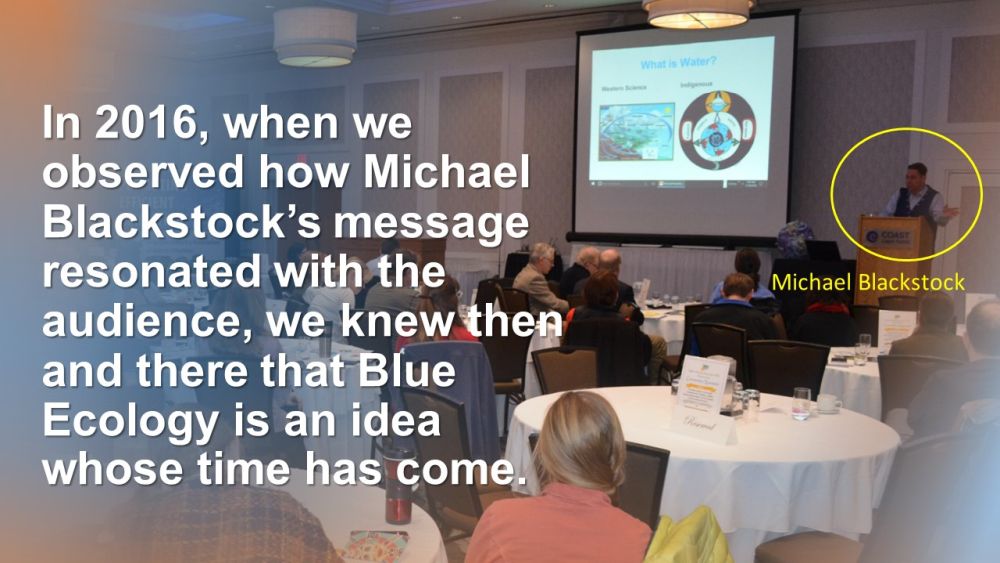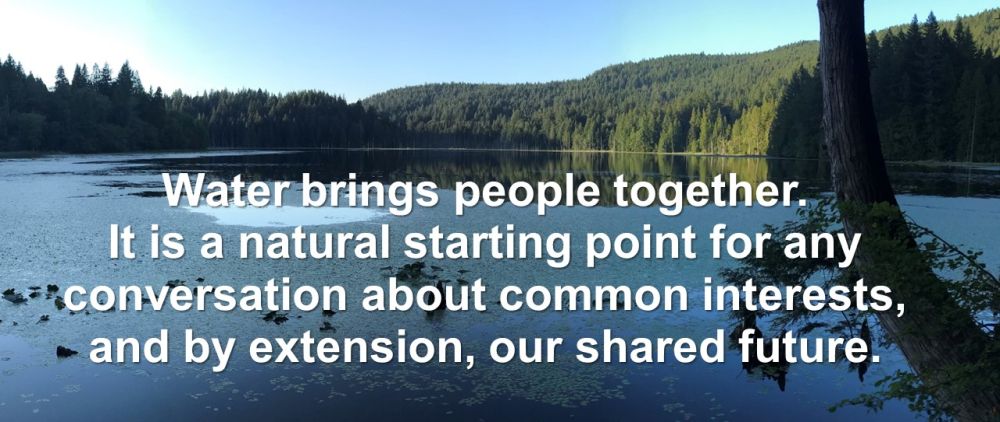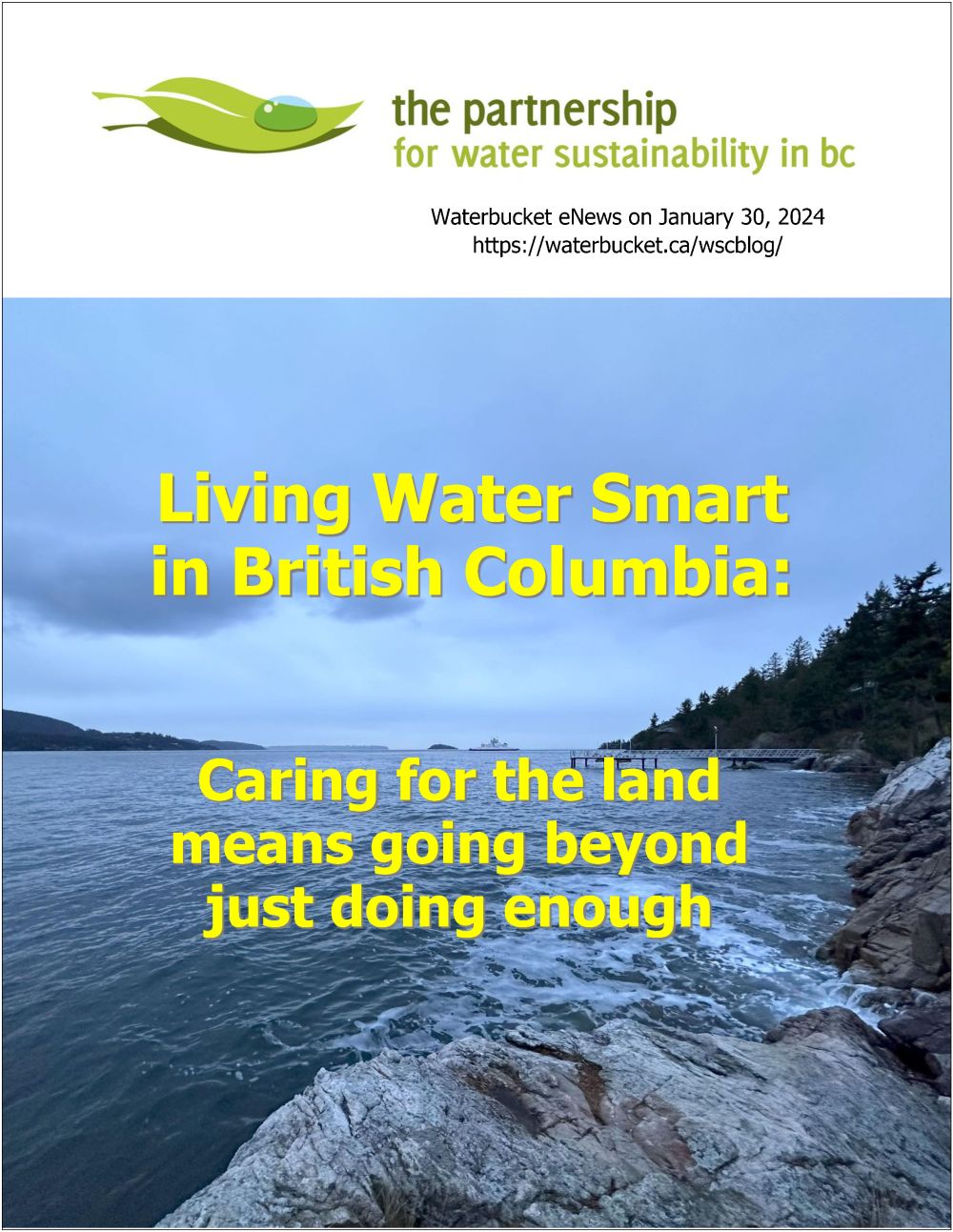DESIGN WITH NATURE TO RESTORE STREAM HEALTH: “Streams need a place to be. If we cannot get our heads around that, we are not going to keep our streams,” stated Tim Pringle, Chair of the Ecological Accounting Process Initiative
Note to Reader:
Published by the Partnership for Water Sustainability in British Columbia, Waterbucket eNews celebrates the leadership of individuals and organizations who are guided by the Living Water Smart vision. The edition published published on January 30, 2024 foreshadows the component program that the Partnership will deliver at the 2024 BC Land Summit in May.
The BC Land Summit is a watershed moment for showcasing new ideas. The audience is comprised largely of players involved in some form of land-related profession, that is: land appraisal, real estate, land planning, agrology, landscape architecture. Their thinking is financial to quite an extent. And because EAP, the Ecological Accounting Process, is a financial approach, the Partnership anticipates that EAP will resonate with them.
EAP and Michael Blackstock’s Blue Ecology are strategic priorities of the Partnership. The process for interconnecting the two begins at the BC Land Summit with a cascading and integrated sessions under the banner Caring for the land means going beyond just doing enough. In this story behind the story, Tim Pringle and Michael Blackstock reflect on their interaction since 2016 and what interconnecting EAP and Blue Ecology is all about.
At the 2004 Land Summit, Tim Pringle will present the methodology and metrics for tackling the Riparian Deficit. And he will introduce the training program now underway at Vancouver Island University to prepare next generations of local government staffs.

STORY BEHIND THE STORY: Caring for the land means going beyond just doing enough – extracts from “Tim Pringle and Michael Blackstock in conversation”
Looking back, a provincial Water Sustainability Workshop in Kelowna was the genesis for collaboration between Michael Blackstock and Tim Pringle. Held in 2016, and co-hosted by the Partnership, the Kelowna event initiated the Partnership’s decision to introduce Michael Blackstock’s work to our local government partners.
The Kelowna workshop was a seminal moment. It marks the first time that Michael Blackstock and Tim Pringle made public presentations in a local government setting on Blue Ecology and EAP, respectively.
A 7-year journey, latterly as members of the Watershed Moments Team, is the frame of reference for Michael and Tim’s collaboration since the Kelowna workshop. In the course of this journey, Michael and Tim have been evolving the philosophies and methodologies for Blue Ecology and EAP, respectively.

An attitude change costs nothing
Along the way, Michael and Tim each recognized that the other had the same important message for audiences: take responsibility for care of the land. It was not until the end of 2023, however, that the aha idea clicked for interconnecting Blue Ecology and EAP.
Coupled with the timely invitation to partner with the BC Land Summit Society, the Partnership has a “springboard opportunity” to promote an attitude change grounded in caring for the land.
We are implementers
“I am an implementer. That reflects my career history,” stated Michael Blackstock in conversation with Tim Pringle. “Blue Ecology theory emerged from practice and from my experience on the frontlines as a forester and as a mediator and a negotiator for the provincial government and BC Hydro over the past 35 years. That is where I saw the gap and the need for Blue Ecology.”
“We are both implementers,” Tim Pringle agreed. “When I reflect on my former career as executive director for the Real Estate Foundation, much of it had to do with getting a deeper understanding of WHY and WHAT proponents wanted to do with our funding. I often travelled to where they worked to see situations from their perspectives. This helped me understand how the foundation could support change in communities that would be for the better.”
Understanding begins with a conversation
“So, the story behind this story is that Tim and I recognized our parallel paths and then we joined our efforts,” summarized Michael Blackstock. “We did that because we took time to stop and listen to the perspective on the other side.”

EAP builds on the “big idea” that use and conservation of land are equal values
Tim Pringle agreed with Michael Blackstock’s observation (above), and added that, “The story of how we came together is that, through both Blue Ecology and EAP, we are striving to implement change consistent with the principle that use and conservation of land are equal values. That is the BIG IDEA.”
“Where we come together is in recognizing the importance of water and the environment, or rather the ecological assets, in those two contexts. We both understand that water and ecological assets are key to the wellbeing of our communities and key to each other. The more specific idea is who will take responsibility for care of the land?”
Now what
This prompted Michael to ask Tim, “Has the moment come to reframe ‘ecosystem services’ as ‘gifts of nature’? If it does not get measured, it does not get managed. EAP helps us measure and assess the trade-offs; and helps us understand when it is time to just let the land heal.”

Blue Ecology is a collaborative framework for action at the local scale where communities decide to take action
“Blue Ecology is about interweaving two ways of knowing through a collaborative framework that would help facilitate how Indigenous, provincial and local governments work as leaders on a common problem, the climate crisis. I believe the public intuitively understands ‘water is life’, and therefore why the Province would focus on water as the core strategy in climate action,” explained Michael Blackstock.
“I agree with your thesis,” stated Tim Pringle. “The foundational ideas behind what we advocate are IMPLEMENTATION and RESPONSIBILITY. And there is a third idea named OPPORTUNITY. By interconnecting Blue Ecology and EAP, we are also creating a common opportunity. Once all the players acknowledge the common opportunity and goal, it makes it that much easier to understand the philosophy behind Indigenous and Western approaches.”
What interweaving means
“Blue Ecology is a tested and credible pathway to hope and reconciliation. By translating what interweaving Indigenous knowledge and Western science means in practical terms for water resource management, the hope is that public service managers will understand and buy-in to the idea,” concluded Michael Blackstock.

To learn more about Blue Ecology, download a copy of Living Water Smart in British Columbia: Oral history extends the period of record and our understanding of what the data mean.
To Learn More:
To read the complete story, download a copy of Living Water Smart in British Columbia: Caring for the land means going beyond just doing enough. The downloadable version includes a Bonus Feature – more from “Tim Pringle and Michael Blackstock in conversation”.
DOWNLOAD A COPY: https://waterbucket.ca/wcp/wp-content/uploads/sites/6/2024/01/PWSBC_Living-Water-Smart_EAP-is-an-expression-of-Blue-Ecology_2024.pdf


